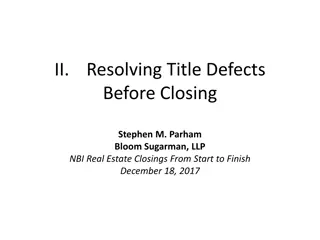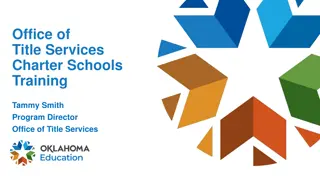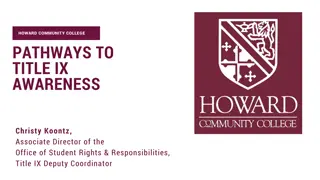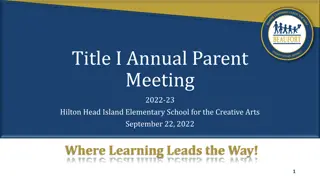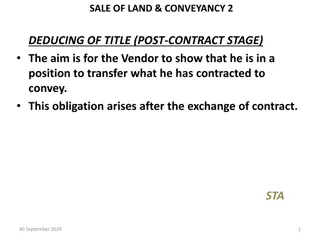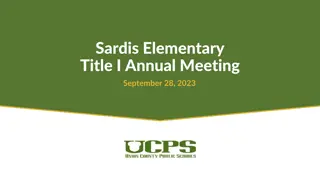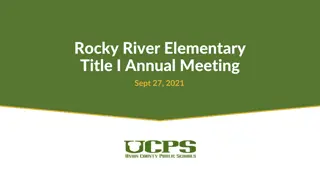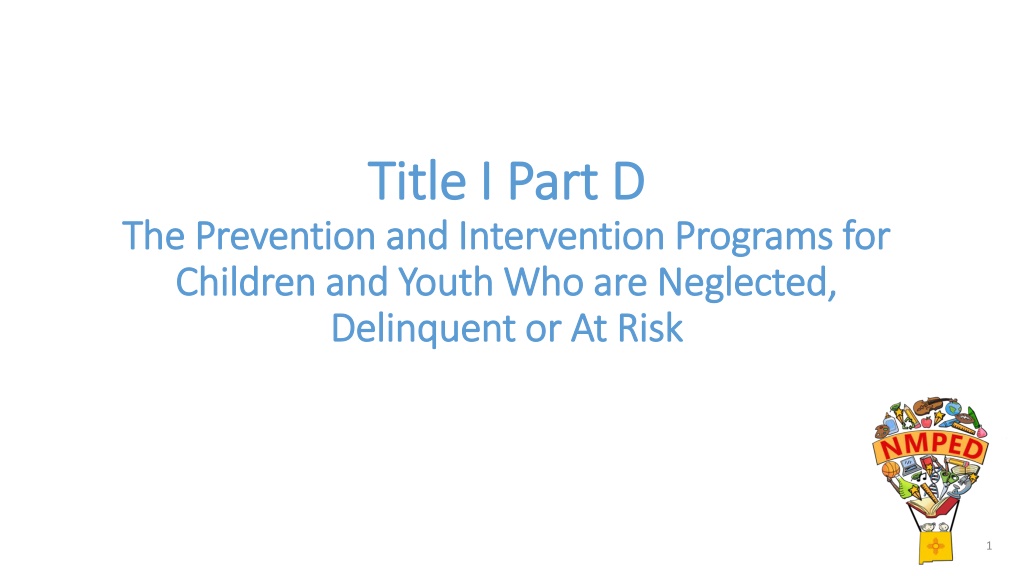
Prevention and Intervention Programs for Neglected, Delinquent, and At-Risk Children and Youth
Explore Title I, Part D which focuses on providing educational services and support for neglected, delinquent, and at-risk children and youth, aiming to prevent dropout, facilitate successful transitions, and improve academic outcomes. Learn about the definitions, objectives, and goals outlined within this program to address the unique needs of these vulnerable populations.
Download Presentation

Please find below an Image/Link to download the presentation.
The content on the website is provided AS IS for your information and personal use only. It may not be sold, licensed, or shared on other websites without obtaining consent from the author. Download presentation by click this link. If you encounter any issues during the download, it is possible that the publisher has removed the file from their server.
E N D
Presentation Transcript
Title I Part D Title I Part D The Prevention and Intervention Programs for The Prevention and Intervention Programs for Children and Youth Who are Neglected, Children and Youth Who are Neglected, Delinquent or At Risk Delinquent or At Risk 1
Title I Part D Neglected and Delinquent Students Neglected The term neglected, when used with respect to a child, youth, or student, means an individual who has been committed to an institution (other than a foster home) or voluntarily placed under applicable State law due to abandonment, neglect, or death of his or her parents or guardians. Delinquent The term delinquent, when used with respect to a child, youth, or student, means an individual who resides in a public or private residential facility other than a foster home that is operated for the care of children and youth who have been adjudicated delinquent or in need of supervision. 2
What is Title I Part D At Risk Students At Risk Is at least 1 year behind the expected grade level for the age of the individual Has limited English proficiency The term at-risk, when used with respect to a child, youth, or student, means a school-aged individual who is at risk of academic failure Is a gang member Dependency adjudication or delinquency adjudication Has dropped out of school in the past Has a high absenteeism rate at school Has a drug or alcohol problem Is pregnant or is a parent Has come into contact with the juvenile justice system or child welfare system in the past 3
Title I Part D Neglected and Delinquent Students NM State Law NM State Plan New Mexico Statutes of 1978 annotated (NMSA), Chapters 22 and 22A comprise the laws regulating Public Schools. Children and youth who are residents of the State and have not yet received a high school diploma are entitled to a free public education (NMSA 22-1-4). The state institution in which a school age person is detained or enrolled shall be responsible for providing educational services for the school age person (NMSA 22-12-4). It is important that you read the New Mexico PED s Consolidated ESSA State Plan and particularly, pages 160-163 regarding Title 1 Part D. Be certain that the services you propose in your application are aligned with the goals, objectives and performance measures as outlined in this State Plan. 4
Main Goals Improve Educational Services for children Provide Neglected and Delinquent youth a successful transition from institutionalization to further school or employment. Prevent youth from dropping out of school Provide youth who have dropped out and youth returning from correctional facilities with a system to ensure their education. 5
Title I Part D Subpart 1 Programs State Agencies New Mexico Corrections Department Juvenile justice (Children, Youth and Families Department) Sequoya Adolescent Treatment Center (Department of Health) 6
Title I Part D Subpart 2 Programs Local Education Agencies Neglected Programs Delinquent Programs At-Risk Programs 7
Annual Child Count The Annual Count is an annual survey that collects an estimate of the number of students who are eligible for Title I Part D funds in New Mexico. Eligibility for Counting and eligibility for Serving are different. Subpart 1: State Agency Eligibility Subpart 2: Local Educational Agency Eligibility A State agency is eligible for assistance under this subpart if such State agency is responsible for providing free public education for children and youth: In institutions for neglected or delinquent children and youth Attending community day programs for neglected or delinquent children and youth; or In adult correctional institutions. For an LEA to be eligible and receive Title I Part D Subpart 2 funding, an LEA must meet at least one of the following criteria: Must serve student(s) who live in a residential facility for neglected or delinquent youth. Must have a residential facility for neglected or delinquent youth located within its boundaries. 8
Annual Child Count Subpart 1: Institution Eligibility Institutions that serve children and youth who are neglected or delinquent AND have an average length of stay of at least 30 days. Subpart 2: Institution Eligibility Locally operated institutions that meet the definition of an institution for neglected children, an institution for delinquent children and youth who serve children and youth who are neglected or delinquent. Subpart 1: Student Eligibility Students who are in a program for youth who are N or D (including juvenile and adult correctional facilities and community day programs), aged 20 years or younger, are enrolled in a regular program of instruction for at least 15 hours/week in an adult facility, or 20 hours/week in a juvenile facility or community day program are eligible to be counted. Subpart 2: Student Eligibility Students who resided in the facility during the 30-day count period, aged 5 to 17 (upon entry to the facility) are eligible to be counted. Students must not be counted in the enrollment data submitted to ED for Subpart 1 State agency N or D program allocation purposes. 9
Count Window Subpart 2: Local Educational Agency The State Educational Agency (SEA), PED selects the count period for all LEAs to use. This period is 30 consecutive days, at least one day must be in the month of October. Subpart 1: State Agency Select a date: The SA selects any 1 day during the current calendar year. Every institution uses the same date Institutions adjust the count to reflect the length of the school year of the specific agency or Institution (single day count) (length of school year in days) 180 10
Regular Program of Instruction An educational program (not beyond grade 12) in an institution or a community day program for children who are N or D that consists of classroom instruction in basic school subjects such as reading, mathematics, and vocationally oriented subjects, and that is supported by non-Federal funds. Neither the manufacture of goods within the institution nor activities related to institutional maintenance is considered classroom instruction. 11
Eligible Students Served Subpart 1: State Agency Subpart 2: Local Educational Agency Students are eligible to be served who are in a program for youth who are Neglected or Delinquent (including juvenile and adult correctional facilities and community day programs). Aged 21 or younger, are enrolled in a regular program of instruction. Are enrolled in a program that meets the length of stay requirements for a given program type (requirements may vary). Students are eligible to be served who are in a locally operated institution for youth who are Neglected or Delinquent. Aged 21 or younger. Students identified as At-Risk 12
Performance Report The purpose of the performance report is to collect program data that the U.S. Department of Education (ED) can use to demonstrate the effectiveness of the Part D program. Subpart 1 and Subpart 2 programs collect data for the same indicators, focusing on four main areas: Student and facility counts Demographics (race/ethnicity, age, gender, etc.) Academic and vocational outcomes Academic performance in reading and mathematics 13
Performance Report The performance report requests data for the previous school year, which is typically defined as July 1 June 30. Part D data can be used by Administrators, Teachers, and others in many ways, including: To review and improve the quality of the data itself. To conduct needs assessments and program evaluations. To share and disseminate information with students, parents, and other shareholders. For example, the data are entered in the CSPR in January and February for the school year that ended the previous summer. 14
Performance Report-Data Review Data reviews during monitoring visits help determine if growth is occurring within the education program. Data-based decision-making can only occur when the data are of high quality and reliable. The data is used to calculate funding, drive decision-making and as it is shared publicly; it is important that it is accurate. It is also important to note that the Average Number of Days Served is the number of days that Educational Services were provided to students during their stay at the facility. This is different from the Average Length of Stay which is the average number of days spent in the facility. 15
Facilities Program Plan Why should a facility Plan Funding? To be more effective: Foster better outcomes for youth Meet Federal, State, and local requirements Meet program, agency, and facility goals and mandates Ensure future Federal program funding To be more efficient: Do more with less in times of financial struggle Effectively administer Part D along with other responsibilities 16
Facilities Program Plan Where to Start? Begin the Program Plan with the Needs Assessments: Can be conducted at the State and facility/program levels Can focus on a single interest area or a whole system or program Can be completed by: Defining the purpose and scope Establishing a planning team Identifying desired data, availability, usability, and collection methods Analyzing data, identifying needs, and setting priorities 17
Facilities Program Plan Needs Assessment Information: Students demographics and their unique needs What additional supportive services are needed Academic and vocational outcomes Transitional/post release outcomes Professional development needs Relationships and their quality 18
Facilities Program Plan Important Questions To Ask: Where are we now? Where do we need to be? How can we get there? How are the needs of neglected, delinquent and at-risk students being identified? What data factors are being utilized to identify the needs? How often are those needs assessments re-evaluated? (Ex: before, during, and end of the school year) 19
Facilities Program Plan Each Program Plan should include: A Program Plan: Describe the program goals Measurable objectives Performance measures established by the facility that will be used to assess the effectiveness of the program in improving the academic, vocational, and technical skills of children in the program Children will have the same opportunities to achieve as if they were in their local/community schools For meeting the Educational needs of children For assisting in the Transition of children and youth from correctional facilities to locally operated programs That is integrated with other programs under this Act or other Acts, as appropriate. 20
Use of Funds Allowable Expenses Not Allowable Tutoring Liaison/Coordinator Classroom Assistant Supplemental classroom supplies and technology Supplemental Professional Development Counseling/Mentoring Services Dropout Prevention Vocational/Technical/Life Skills Education Items that would be used by students that are not considered neglected, delinquent, or at-risk. Anything that would not be directly related to education or transition. 21
Supplement not Supplant Supplement, not Supplant Title 1 Part D grant funds may only be used to provide services that supplement, not supplant, those services that would, in the absence of funds, be provided to children participating in the regular school education program. However, funds may be used to increase the total number of hours of instruction in reading, language arts, mathematics, or vocational/CTE courses, which are integrated and aligned with state academic standards and that students receive with State or local funds. 22
Monitoring Facilities are monitored under Title I Part D every three years. The PED is required to monitor the implementation of program requirements and the expenditure of federal funds. New Mexico s monitoring process consists of four major components: Monitoring of Standards. Assessment, and Accountability. Instructional support. Expenditures. 23
Application Title 1 D Program Applications Both Title 1 Part D Subpart 1 and Title 1 Part D Subpart 2 Applications will be available in SharePoint. Be certain that the services that are proposed in the Application and the Needs Assessment are aligned with this purpose. Carefully read the all the Federal requirements outlined in the Applications to ensure the facility follows the requirements. Be sure that the services that are provided with the Title 1 Part D funds are all Supplementalto the State s required educational program and not supplanting any state education programming activity. 24
Transition Services Support Services to Ensure Success of Youth Examples: Personal, vocational/technical and academic counseling Placement services designed to place the youth in a university, college, or junior college program Information concerning, and assistance in obtaining, available student financial aid Job placement Student transition folder with exiting information of Transcript, Career Scope, individual state testing results, etc. Guest speakers will also be used to introduce students to possible career paths. 25
Contact Information Dr. Nicole O Shea Title 1 Part D Coordinator Student, School, and Family Support Bureau New Mexico Department of Education Email: nicole.oshea@ped.nm.gov Phone: (505) 531 7389 26



